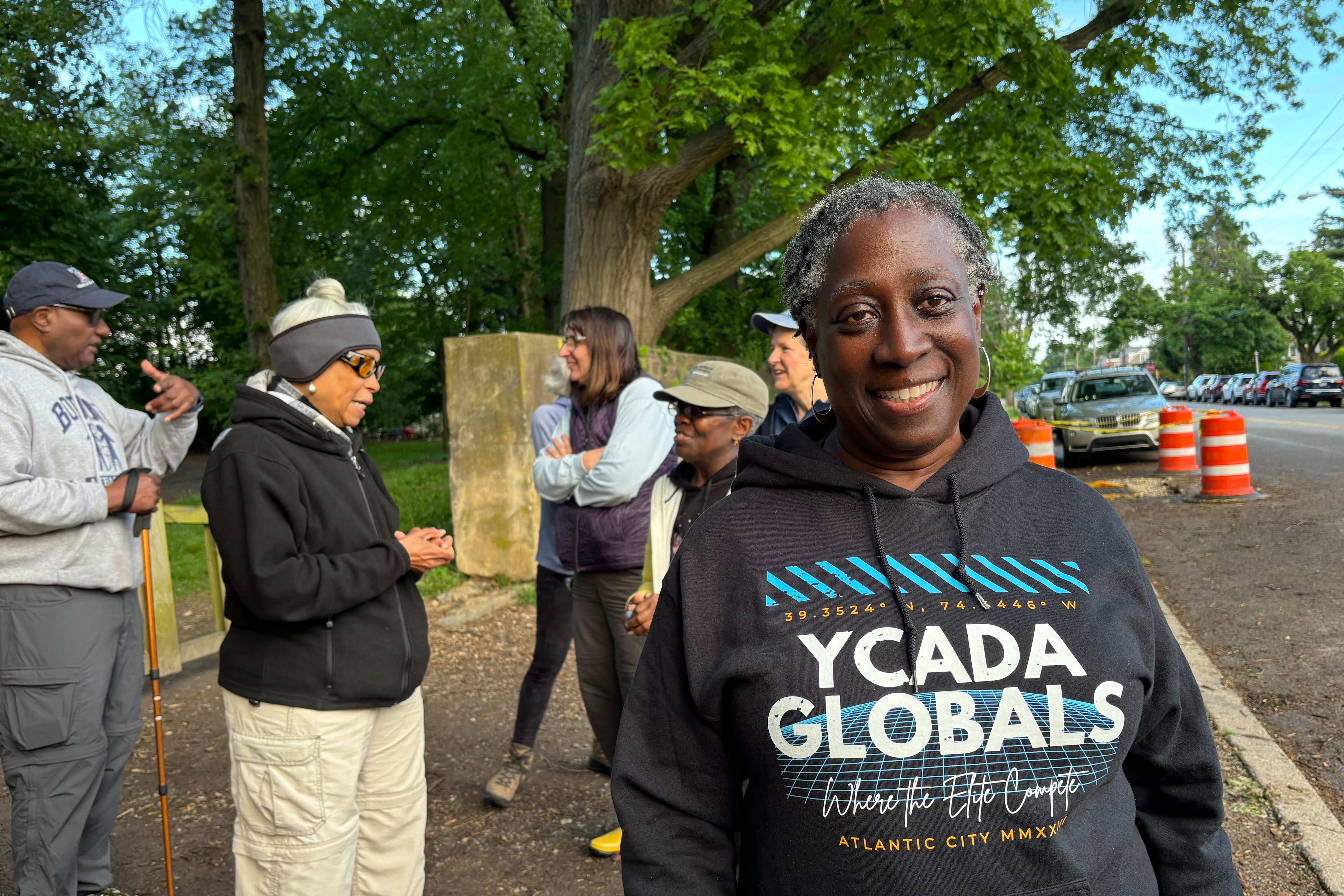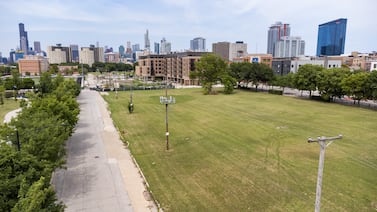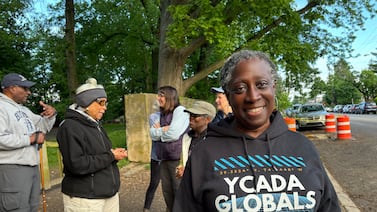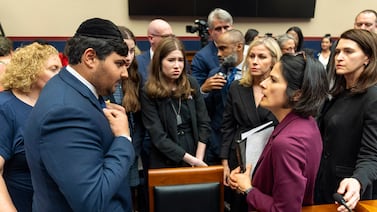Sign up for Chalkbeat Philadelphia’s free newsletter to keep up with the city’s public school system.
In 1969, Debra Matthews was almost nine years old and looking forward to fourth grade with her friends at Rowen Elementary when her mother told her she would be going to a different school five miles away from her West Oak Lane home.
“I didn’t have a choice,” Matthews recalled. Rowen had just built a brand new annex building that Matthews had been excited to explore. “I thought I would be going there. I was looking forward to that.”
Instead, until she graduated, Matthews, who is Black, rode a bus every morning, about a half hour each way, to predominantly white Northeast Philadelphia. First in a schoolbus to J. Hampton Moore elementary, then via SEPTA to Woodrow Wilson Junior High, now Castor Gardens Middle School, and then to Northeast High School.
All in the name of school desegregation.
This month marks the 70th anniversary of what is perhaps the most consequential U.S. Supreme Court decision of the 20th century, Brown v. Board of Education, which outlawed Jim Crow laws in 17 states that required Black and white children to be educated in separate schools.
As the nation commemorates Brown, Philadelphians are reflecting on their own long and complicated history with school segregation.
Philadelphia was a city where segregation was not de jure, or imposed not by the laws that Brown struck down, but instead de facto – the result of personal choices, such as where people choose to live, that led to massive white flight.
For some civil rights leaders of the time, Philadelphia was a perfect test case for challenging segregation in many Northern states. While a federal case was never filed, the district experienced more than 40 years of litigation and oversight from the Pennsylvania Human Relations Commission aimed at integrating schools.This resulted in generations of students like Matthews, almost all of them Black, bused to schools outside of their neighborhoods and decades of court pressure to implement other policies designed to end segregation.
But, today, the city’s students are still largely attending some of the most segregated and under resourced schools in the country. The district is 50% Black and 14% white, while the city’s overall demographics are nearly 40% Black and 34% white, reflecting a longstanding pattern of most white families attending private schools. Although the city is home to a few of the most racially-mixed schools in the state, a new study out of Stanford University found Philadelphia’s schools overall remain nearly as segregated as they were 30 years ago. White students are concentrated in a little over a dozen mostly special-admissions schools and comprise just a tiny percentage in the vast majority of neighborhood schools, the study found.
In the 70 years since Brown, “Segregation in the North has gotten worse, and the Philadelphia area is no exception to that,” said Michael Churchill of the Public Interest Law Center, a legal advocacy group.
Advocates like Churchill haven’t given up on desegregation as an ideal, but they have shifted focus to the new frontier in educational equity – school funding
“The schools that have the most minority children also have the least funding,” said Churchill, who has represented plaintiffs in the lawsuit seeking fair and adequate school funding in Pennsylvania. “And as difficult as it may be to fix the physical segregation of students, there is absolutely no excuse why there should be such funding disparities.”
The Brown anniversary comes at a time when Pennsylvania’s governor and state legislature are grappling with reforming the state’s funding system in the wake of Commonwealth Court Judge Renee Cohn Jubelirer’s February 2023 decision declaring it unconstitutional. She said Pennsylvania overly relies on property taxes to fund education, depriving students in poorer areas of a “thorough and efficient” education. And she concluded, drawing on research and testimony, that Black and Latino students are disproportionately located in districts with inadequate funding.
While Philadelphia is surrounded by overwhelmingly white, better-funded suburban districts, the lead plaintiff in the school funding case is the William Penn School district on the city’s southwest edge, itself an example of de facto segregation: after more Black families moved into the district, white families once again left, perpetuating the largely separate and unequal system. Property values went down, tax rates went up, and those who could afford to move did.
And that unequal system has been proven to harm Black students, Hispanic students, and students from low-income backgrounds by depriving them of experienced teachers and educating them in aging buildings without proper temperature controls and often plagued with lead and asbestos, among other challenges.
“There is an anti-big city, anti-urban attitude,” said Roseann Liu, a visiting professor at Swarthmore College, at an event for her recently published book “Designed to Fail: Why Racial Equity in School Funding Is So Hard to Achieve,” which is a case study of the issue in Pennsylvania.
“What that really means is anti-Black. … I don’t think that state legislators are racists, but there is something to be said about people in power holding ideas about the value of different kinds of children.”
The history of desegregation efforts in Philadelphia
For decades until the 1970s, the school district strictly enforced policies and practices clearly designed to segregate its schools.
In the early and mid-twentieth century as they built new schools to accommodate the city’s growing population – including many Black families moving from the South – officials drew school catchment area boundaries to segregate students as much as possible.
And well into the 1950′s, the district maintained segregated elementary schools to employ a growing cadre of Black teachers and principals. The white power structure of the day was steadfast in opposition to allowing Black teachers to teach white students and to having black principals supervise white teachers.
While some practices had eased by then – there were a handful of Black teachers and principals in high schools – discrimination was still very much in evidence in 1970, when the Pennsylvania Human Relations Commission, which had begun monitoring city schools several years before, filed a complaint against the district. The commission, which at the time had the power to enforce anti-discrimination laws, wanted mandatory busing to remedy segregation.
School officials fought any effort to forcibly bus students out of their neighborhoods, especially white students, but they did agree to a voluntary plan in which students like Matthews took part. They also agreed, in the 1970s, to create several new, specialized schools such as George Washington Carver High School of Engineering and Science in the hopes of attracting a diverse student body.
When Constance Clayton became the city’s first Black (and first female) superintendent in 1982, she and her chief of staff, Penn law professor Ralph Smith, devised a more sweeping plan to satisfy the commission.
Clayton’s plan had two major components. One was to provide extra resources, including free extended day activities and art, music, and technology programming, to mostly Black schools in racially integrated areas as an incentive for white students to attend. Such a school was considered successfully desegregated if it reached 25% white population.
The second component was aimed at the significant number of neighborhood schools that remained virtually all-white, most in Northeast Philadelphia. Under this initiative, the district vastly expanded the voluntary busing program, with the goal of reaching 40% Black enrollment in as many of these schools as possible. Many more thousands of students than was the case in Matthews’ time were bused starting in the Clayton era.
While the voluntary busing did change the demographics of many schools, the commission, which continued to advocate for mandatory busing, took the district to court again in the 1990s. By that time, with more desegregation becoming virtually unattainable, the case evolved to focus on the adequacy and equity of funding.
Commonwealth Court Judge Doris Smith-Ribner ordered the district to invest more resources in the district’s poorest, “racially-isolated” Black schools. But when she also ordered Harrisburg to send Philadelphia more money to help pay for this, the state Supreme Court summarily took her off the case and the state legislature largely ignored her directive.
Around that time, when Superintendent David Hornbeck called the state’s education funding system “racist,” Gov. Tom Ridge took umbrage at the comment, an incident that helped precipitate the state takeover of the Philadelphia school district in 2002. The state controlled the district until 2018, an era that saw the rise of charter schools as the primary reform effort to improve the education of low-income, Black, and Hispanic students.
The busing continued until 2009, when the district’s second black superintendent, Arlene Ackerman, asked that it be ended, citing the expense of busing and a waning commitment to desegregation itself for its own sake.

“Integration 2.0″
As the nation reflects on the Brown anniversary, Philadelphia educators and policymakers have been pondering what next steps should be.
“The other legacy of Brown, is when desegregation did happen it was done at the expense of Black communities,” said Erica Frankenberg, who studies the subject at Pennsylvania State University. “It was done inequitably in that it made some communities question the importance of it.”
She said she has been “thinking about this idea of what would integration 2.0 look like, integration in a multi racial way, with equitable sharing who has to travel, making sure what is reflected in the curriculum and history classes, integrated teachers. All of that is done in some places, but it is not widespread.”
Sharif El-Mekki, a former school district and charter school principal who now runs the Center for Black Educator Development, said Brown was invaluable in that it invalidated what he described as an “apartheid” system. At the same time, he said, quoting activist Stokely Carmichael, it is not segregation per se, “but white supremacy we should be fighting against. What’s important is that we don’t have government-sanctioned forms of segregation.”
El-Mekki, who is working hard to recruit more Black teachers at a time when their attrition rate is greater than that for white teachers, said while the government and institutions should be vigilant about discrimination, they should also be doing more to support “all-Black spaces that are holistic and affirming.”
To mark the anniversary, Desireé Chang, the Director of Education and Outreach at the state Human Relations Commission that pursued the Philadelphia case for so long, said there is still work to be done.
“Students living in lower income communities are deprived of the same resources provided to students in higher income communities,” she said. “This underfunding has led to crowded classrooms, fewer teachers and outdated schools, textbooks, and an overall unequal education.”
In in Black community where Debra Matthews grew up, and still lives, and in others like it, there was long the assumption that schools with white students would be better than the one in the neighborhood. The students taking the opportunity to travel from Rowen to the Northeast filled the school bus.
Matthews, now 63, can’t say for sure how or whether she benefited from her experience traveling far from her home to attend school, having nothing to compare it to. She noted that at J. Hampton Moore, the building was more modern, the gym had more equipment, and the schoolyard was bigger than at Rowen. She recalls that she made new friends and enjoyed “a rainbow of classes.”
She remembers that at Rowen she had been on an accelerated track, whereas in her new school she was not. After her mother complained, however, she was switched.
And she recalls that when she arrived, as a nine-year-old, several of the girls in the class had letters from their parents saying that they were not to sit next to any Black students. And the teacher complied.
But, she said, over time, she made friends, even with some of the girls who had the letters. In an era when many students went home for lunch, something the bused-in students couldn’t do, she was invited to go home with a classmate.
“I did that one time, and I wasn’t impressed,” she said, laughing, recalling that the only difference between her Philadelphia rowhouse and theirs – down to the plastic covers on the furniture – was that her friend’s mother didn’t toast their bread.
“I thought I was going to see something with more splendor, grandeur. But they were just an average family. And I was missing pizza day.”
There were occasional conflicts and awkward incidents, but by fifth and sixth grade she and her girlfriends were sitting around together cutting out pictures from magazines of their favorite idols, which included both the Osmonds and the Jackson 5.
“We got along,” she said. “Sometimes, if adults just let children be children and stop trying to spread beliefs onto them, it will work out.”
Dale Mezzacappa is a senior writer for Chalkbeat Philadelphia, where she covers K-12 schools and early childhood education in Philadelphia. Contact Dale at dmezzacappa@chalkbeat.org.







